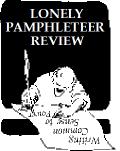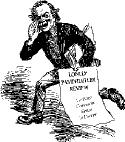MAY
1, 2005 --
April
27th was the 183rd birthday of Ulysses S. Grant. Rain sent the
commemoration inside the rotunda of Grant's Tomb, on Manhattan's
Upper West Side, for the first time since the ceremony was renewed
in 1997 on the occasion of the 100th anniversary of this memorial
to the great Civil War general and the nation's 18th president.
President Grant's wife Julia is also interred at this mausoleum. General Grant
was a member of West Point's Class of 1843 and the ceremony included representatives
from the United States Military Academy, led by Brigadier General Michael Scaparrotti,
Commandant of the Corps of Cadets, who
was guest speaker and placed a wreath sent by President Bush.
Gen. Scapparrotti reviewed the career
of President Grant and then noted that the cadets at the ceremony will receive
their commissions as second lieutenants in 30 days. "This is an army at
war," he remarked, indicating that the cadets " are traiined to serve," and
are "shining examples of excellence."
The ceremonies included presentation of a flag by Daniel Olmsted, from the
Oneida Indian Nation. An Oneida ancestor of Mr. Olmsted fought art the Battle
of Saratoga, considered the turning point in the American Revolution.
Craig Polhamus, an architect in Fayetteville, New York, presented tools used
by his great-grandfather, Henry Adam Boll, as a stonecutter on the construction
of Grant's Tomb.
Before the official ceremony got underway, members of the National Park Service,
and volunteers, met with children from Westchester County schools -- New York
City schools were on spring break --telling them what life was like for Union
soldiers. Interpretative Ranger Charles Kahlstrom was dressed in the uniform
of
the 20th New York, a German-American regiment.
Volunteer Jonathan Gunning was dressed in the uniform of a soldier in the 31st
Illinois which, he noted, fought 15 battles in the Civil War and was "always
on the march." Mr. Gunning indicated that there was some rivalry between
western and eastern Union troops.
Mr. Gunning noted that westerners called eastern troops "paper-collar
soldiers." Mr. Kahlstrom pointed out that 200 Union regiments were formed
in New York State, totaling 500,000 troops of the 2 million
soldiers who served on the Union side.
Mr. Kahlstrom also noted that Union forces were named for rivers -- hence the
term,"the Army of the Potomac."
Both Mr. Kahlstrong and Mr. Gunning described their uniforms and weapons for
the schoolchildren.
When the ceremony was concluded, the sky cleared for the firing of Civil War
rifles and rifle-muskets, and a cannon used in the Mexican and Civil wars.
The battery was led by Denny Pizzini of Winslow's Battery D, First New York
light artillery, based on Staten Island.
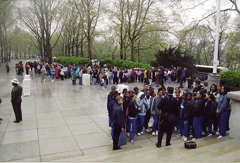 |
Clusters
of school children in the
plaza in front of Grant's Tomb.
|
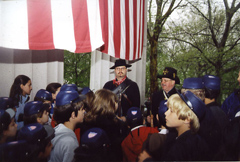 |
Jonathan
Gunning, left, and
Charles Kahlstrom, right, speaking to the school children.
|
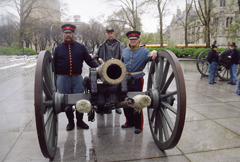 |
Cannon
used in the Mexican and Civil Wars.
|
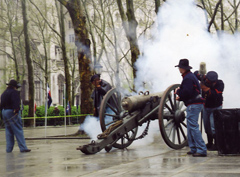 |
The
firing of the cannon. The battery was led by Denny Pizzini
of Winslow's Battery D, First New York light artillery,
based on Staten Island.
|
|
